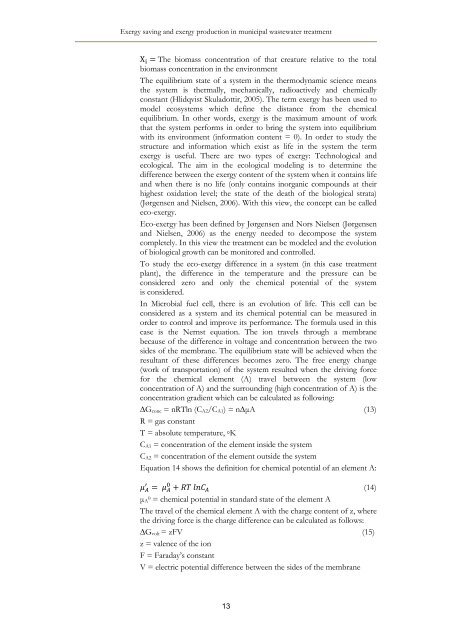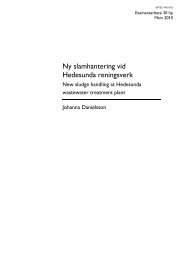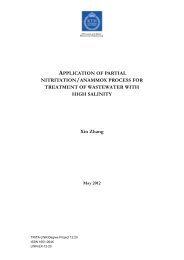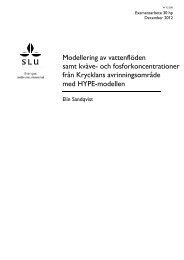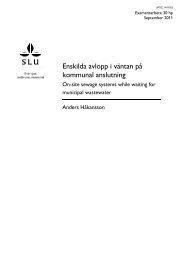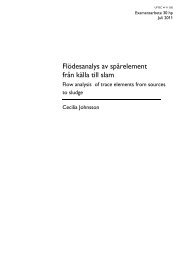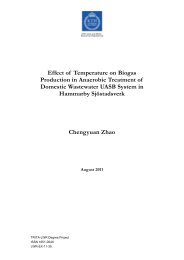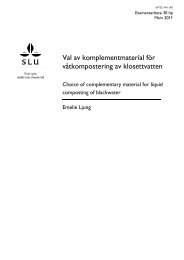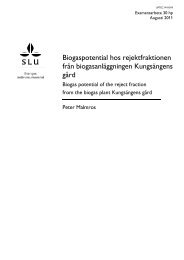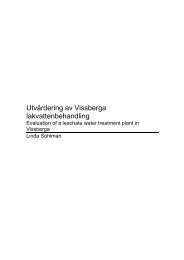Exergy saving and exergy production in municipal wastewater ...
Exergy saving and exergy production in municipal wastewater ...
Exergy saving and exergy production in municipal wastewater ...
Create successful ePaper yourself
Turn your PDF publications into a flip-book with our unique Google optimized e-Paper software.
<strong>Exergy</strong> <strong>sav<strong>in</strong>g</strong> <strong>and</strong> <strong>exergy</strong> <strong>production</strong> <strong>in</strong> <strong>municipal</strong> <strong>wastewater</strong> treatment<br />
The biomass concentration of that creature relative to the total<br />
biomass concentration <strong>in</strong> the environment<br />
The equilibrium state of a system <strong>in</strong> the thermodynamic science means<br />
the system is thermally, mechanically, radioactively <strong>and</strong> chemically<br />
constant (Hlidqvist Skuladottir, 2005). The term <strong>exergy</strong> has been used to<br />
model ecosystems which def<strong>in</strong>e the distance from the chemical<br />
equilibrium. In other words, <strong>exergy</strong> is the maximum amount of work<br />
that the system performs <strong>in</strong> order to br<strong>in</strong>g the system <strong>in</strong>to equilibrium<br />
with its environment (<strong>in</strong>formation content = 0). In order to study the<br />
structure <strong>and</strong> <strong>in</strong>formation which exist as life <strong>in</strong> the system the term<br />
<strong>exergy</strong> is useful. There are two types of <strong>exergy</strong>: Technological <strong>and</strong><br />
ecological. The aim <strong>in</strong> the ecological model<strong>in</strong>g is to determ<strong>in</strong>e the<br />
difference between the <strong>exergy</strong> content of the system when it conta<strong>in</strong>s life<br />
<strong>and</strong> when there is no life (only conta<strong>in</strong>s <strong>in</strong>organic compounds at their<br />
highest oxidation level; the state of the death of the biological strata)<br />
(Jørgensen <strong>and</strong> Nielsen, 2006). With this view, the concept can be called<br />
eco-<strong>exergy</strong>.<br />
Eco-<strong>exergy</strong> has been def<strong>in</strong>ed by Jørgensen <strong>and</strong> Nors Nielsen (Jørgensen<br />
<strong>and</strong> Nielsen, 2006) as the energy needed to decompose the system<br />
completely. In this view the treatment can be modeled <strong>and</strong> the evolution<br />
of biological growth can be monitored <strong>and</strong> controlled.<br />
To study the eco-<strong>exergy</strong> difference <strong>in</strong> a system (<strong>in</strong> this case treatment<br />
plant), the difference <strong>in</strong> the temperature <strong>and</strong> the pressure can be<br />
considered zero <strong>and</strong> only the chemical potential of the system<br />
is considered.<br />
In Microbial fuel cell, there is an evolution of life. This cell can be<br />
considered as a system <strong>and</strong> its chemical potential can be measured <strong>in</strong><br />
order to control <strong>and</strong> improve its performance. The formula used <strong>in</strong> this<br />
case is the Nernst equation. The ion travels through a membrane<br />
because of the difference <strong>in</strong> voltage <strong>and</strong> concentration between the two<br />
sides of the membrane. The equilibrium state will be achieved when the<br />
resultant of these differences becomes zero. The free energy change<br />
(work of transportation) of the system resulted when the driv<strong>in</strong>g force<br />
for the chemical element (A) travel between the system (low<br />
concentration of A) <strong>and</strong> the surround<strong>in</strong>g (high concentration of A) is the<br />
concentration gradient which can be calculated as follow<strong>in</strong>g:<br />
∆G conc = nRTln (C A2/C A1) = n∆μA (13)<br />
R = gas constant<br />
T = absolute temperature, ◦K<br />
C A1 = concentration of the element <strong>in</strong>side the system<br />
C A2 = concentration of the element outside the system<br />
Equation 14 shows the def<strong>in</strong>ition for chemical potential of an element A:<br />
(14)<br />
μ 0 A = chemical potential <strong>in</strong> st<strong>and</strong>ard state of the element A<br />
The travel of the chemical element A with the charge content of z, where<br />
the driv<strong>in</strong>g force is the charge difference can be calculated as follows:<br />
∆G volt = zFV (15)<br />
z = valence of the ion<br />
F = Faraday’s constant<br />
V = electric potential difference between the sides of the membrane<br />
13


